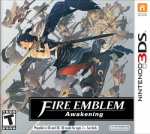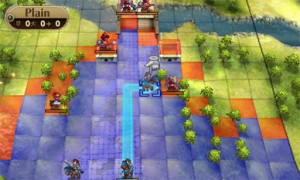Review: Fire Emblem Awakening (3DS)
 While I was unfamiliar with the series, the first Fire Emblem to make its way to US shores was an exciting event for me. It arrived in the heyday of the GameBoy Advance strategy gaming, where strategy titles were just starting to appear for Nintendo’s portable systems. I jumped at a chance to review the game and was surprised to find a rich role-playing backdrop to a turn based strategy game. The game was difficult, but rewarded wise play. While it was a hit among hard core games, I felt the permanent death of battle casualties did not mesh well with the more casual style of play expected from a GBA gaming experience. Several titles and systems later, Fire Emblem Awakening appears on the 3DS as the first handheld version to appear since those bygone days of the GBA. Available as a cartridge or as a download, the game takes great advantage of the dual screens and has options to make it even more approachable to the more casual handheld gaming crowd.
While I was unfamiliar with the series, the first Fire Emblem to make its way to US shores was an exciting event for me. It arrived in the heyday of the GameBoy Advance strategy gaming, where strategy titles were just starting to appear for Nintendo’s portable systems. I jumped at a chance to review the game and was surprised to find a rich role-playing backdrop to a turn based strategy game. The game was difficult, but rewarded wise play. While it was a hit among hard core games, I felt the permanent death of battle casualties did not mesh well with the more casual style of play expected from a GBA gaming experience. Several titles and systems later, Fire Emblem Awakening appears on the 3DS as the first handheld version to appear since those bygone days of the GBA. Available as a cartridge or as a download, the game takes great advantage of the dual screens and has options to make it even more approachable to the more casual handheld gaming crowd.
Fire Emblem titles are basically a turn based strategy wargame with a library of specific, named units who develop in power, ability, and personality throughout an unfolding story arc. Fire Emblem Awakening is no different, starting out allowing you (the main character) to choose a character type and then inserting you into an ongoing story (conveniently) where you have lost your memory. As you travel you meet up with characters in the world and begin to fight off invading armies from other countries (and/or dimensions.) As your entourage grows, you begin to have options for who to bring into the turn-based fights. These decisions are not trivial as your companions increase in level as they fight, so some units need to become “regulars” in order to gain enough experience to be useful in later, more powerful battles. Units that fight together also can unlock ongoing relationships which will allow them special abilities when paired together on the field and can even develop into full-blown pairings resulting in children which could then, in turn, be recruited into your army. Note that in the new game, units can actually “stack” together when fighting to combine forces as compared to previous titles when they simply were moved adjacent to each other.
The strong backstory and RPG-like development of units adds an entirely new dimension to battle tactics on a battlefield. Most games of this type require players to make decisions about attack or defensive positions, holding key locations, use of terrain, and appropriate rock-paper-scissors unit interactions. Fire Emblem has these, but also requires consideration of appropriate pairings of units on the field to develop their interactions, management of unit resources (all units’ weapons have limited uses so must be managed or you will go broke from resupplying your army), the correct use of units to gain experience so that desired units are able to increase in level, and a watchful eye for any units in danger, since death is permanent for any units in the standard game setting. All of these considerations elevates the strategy game portion of the game to something so much more than a typical wargame. You are trying to win the current battle, but in such a way that you are better prepared for future battles as well!
A moment must be given for what I see as one of the best features of the new release. In all previous versions of Fire Emblem, any unit that falls in battle is gone from the game, unless returned in one or two special circumstances later in the story arc. In Fire Emblem Awakening, there is an option for “Casual Mode”. In this mode, fallen units are no longer removed from the game, but are returned at the end of the battle. I admit that this detracts from the strong emotional reaction that can be triggered with the death of a particularly fond unit that a player has developed over the course of the game. However, since the game includes several save game slots, I suspect most gamers would simply restart the game at the beginning of any such battle where they incur a key loss, thus negating the key loss of the unit. When such an option is present, I see no problem with the logical inclusion of a “safety net” feature so that casual gamers, such as myself, who are more interested in the entire story arc than with any hard-core bragging rights can enjoy the game without having to mess with multiple restarts from game saves.
The game interface is exceptionally well done, as it allows for far reaching customization for all the features of combat and interaction, allowing gamers to speed up, slow down, or entirely ignore all sorts of information presented during battles so that they proceed as fast or as slow as one desires. The game frequently uses the 3D mode during cutscenes between combats as the story is developed and it adds a nice sense of background to draw out the story of the more role-playing aspects of the game.
In addition, the game uses the Internet and the StreetPass feature of the 3DS to allow gamers to extend their enjoyment of the game beyond the basic story arc. Additional maps can be downloaded (most purchased) online, and the StreetPass feature allows you to pit your own army up against the current state of any of your StreetPass friends. If you prefer, you can outright purchase (with in-game gold) items or recruit other player’s leaders to join you on your own quest.
Fire Emblem Awakening is a fitting sequel to the previous games. It includes everything that was great about previous titles: good plot and character development crossed with solid turn based gameplay, while adding in some features specific to the 3DS system and to make the game even more accessible to the casual gamer without sacrificing the hardcore game experience for those that want it. I find the game to be a great role-playing title, comprised of an “adventuring” party of dozens of interacting characters. Fans of RPGs or wargames should definitely pick this one up.
Kid Factor: The game and cut scenes require a healthy dose of reading, but the combat is not bloody or disturbing. Defeated foes vanish and defeated allies are more likely to simply “retreat from the field”. The invading monsters do have glowing red eyes, etc… but are unlikely to spawn nightmares in most kids. The relationship interactions between allied units should not be cause for alarm either. They are dealt with tastefully and have basically no offensive sexual content whatsoever. With the complexity of the game, even at the easiest settings, I would recommend it primarily for older kids, say about 10+ of age. Strategy oriented younger ones might still enjoy it, but it could prove difficult in spots.






Discussion Area - Leave a Comment